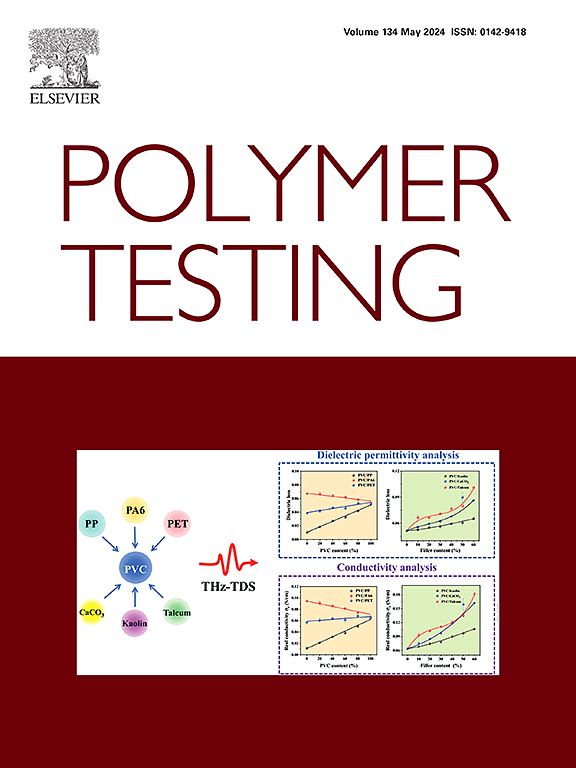Depth-dependent structural analysis of polyolefin multilayer films using microbeam X-ray diffraction
IF 5
2区 材料科学
Q1 MATERIALS SCIENCE, CHARACTERIZATION & TESTING
引用次数: 0
Abstract
Recent tightening of global regulations on plastic waste treatment has promoted the use of single type materials (over 95 %) with similar chemical identities. To meet such a mono-material regulation for upcycling and downcycling, polyolefin (PO) multilayer films comprising polyethylene (PE) and polypropylene (PP) have been most widely fabricated with the other functional layers because of their complementary physicochemical properties. To characterize depth-dependent compositional and structural properties of the PO multilayer films, we propose an analytical integration of a focused ion beam with scanning electron microscopy (FIB-SEM) technique and synchrotron microbeam wide-angle x-ray diffraction (M-WAXD). The two types of PE/(PE + PP)/PE and PP/PE/PP multilayer films were sequentially step-milled using the FIB-SEM, which enabled the high-resolution depth control of the films. The step-milled sculptures of multilayer films were exposed normal to microbeam x-rays in a transmission-mode, providing insights into the composition, nanoparticle dispersion, and crystal orientation as a function of film thickness. Our results highlight the analytical capability using an effective combination of FIB-SEM technique and M-WAXD, pointing out the importance of depth-dependent structural analysis for mono-material PO multilayer films.
用微束x射线衍射分析聚烯烃多层膜的深度相关结构
最近全球塑料废物处理法规的收紧促进了具有相似化学特性的单一类型材料的使用(超过95%)。为了满足这种单材料升级和降级的要求,由聚乙烯(PE)和聚丙烯(PP)组成的聚烯烃(PO)多层膜由于其互补的物理化学性质而被广泛地与其他功能层一起制造。为了表征PO多层膜的深度相关成分和结构特性,我们提出了将聚焦离子束与扫描电子显微镜(fi - sem)技术和同步加速器微束广角x射线衍射(M-WAXD)相结合的分析方法。采用FIB-SEM对两种类型的PE/(PE + PP)/PE和PP/PE/PP多层膜进行了顺序步进铣削,实现了高分辨率的薄膜深度控制。多层薄膜的阶梯研磨雕塑以透射模式正常暴露在微束x射线下,提供了对组成、纳米颗粒分散和晶体取向作为薄膜厚度函数的见解。我们的研究结果强调了FIB-SEM技术和M-WAXD有效结合的分析能力,指出了对单材料PO多层膜进行深度相关结构分析的重要性。
本文章由计算机程序翻译,如有差异,请以英文原文为准。
求助全文
约1分钟内获得全文
求助全文
来源期刊

Polymer Testing
工程技术-材料科学:表征与测试
CiteScore
10.70
自引率
5.90%
发文量
328
审稿时长
44 days
期刊介绍:
Polymer Testing focuses on the testing, analysis and characterization of polymer materials, including both synthetic and natural or biobased polymers. Novel testing methods and the testing of novel polymeric materials in bulk, solution and dispersion is covered. In addition, we welcome the submission of the testing of polymeric materials for a wide range of applications and industrial products as well as nanoscale characterization.
The scope includes but is not limited to the following main topics:
Novel testing methods and Chemical analysis
• mechanical, thermal, electrical, chemical, imaging, spectroscopy, scattering and rheology
Physical properties and behaviour of novel polymer systems
• nanoscale properties, morphology, transport properties
Degradation and recycling of polymeric materials when combined with novel testing or characterization methods
• degradation, biodegradation, ageing and fire retardancy
Modelling and Simulation work will be only considered when it is linked to new or previously published experimental results.
 求助内容:
求助内容: 应助结果提醒方式:
应助结果提醒方式:


